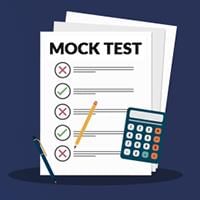CLAT Exam > CLAT Questions > Directions: Read the following passage and an...
Start Learning for Free
Directions: Read the following passage and answer the question.
India faces a tough task ahead: to show its commitment to building the semiconductor industry. Industrial policies with capital may attract investments and potential bids, but favourable trade policies and a conducive business environment can ensure the completion of the projects and yield results. In the long run, this approach can attract more international semiconductor firms. India can be closer to its goals by adopting the following policy recommendations. To begin with, India must change its approach to foreign trade policy and make it more accommodating to the technology sector. The government can then focus on developing a comprehensive trade policy suited or catered to the semiconductor industry itself. Existing mercantilist and distortive trade practices that undermine the tenets of market-based competitiveness in the industry must be eliminated. India should join the World Semiconductor Council to make its voice heard among the semiconductor powerhouses. The Council is a strong proponent of free trade and is guided by the principles of fairness, respect for market principles, and consistency with WTO rules.
[Source - www.news18.com, June 3, 2022]
[Source - www.news18.com, June 3, 2022]
Q. What is the primary challenge that India faces in building its semiconductor industry, as mentioned in the passage?
- a)Lack of skilled workforce
- b)Inadequate capital investment
- c)Hostile international trade policies
- d)Inefficient government policies
Correct answer is option 'C'. Can you explain this answer?
| FREE This question is part of | Download PDF Attempt this Test |
Most Upvoted Answer
Directions: Read the following passage and answer the question.India f...
According to the passage, India faces a tough task in building its semiconductor industry. While capital investment and attracting investments and bids are important, the passage emphasizes the importance of favorable trade policies and a conducive business environment. It suggests that hostile international trade policies could be a significant challenge for India in achieving its semiconductor industry goals. The passage does not explicitly mention a lack of a skilled workforce, inadequate capital investment, or inefficient government policies as the primary challenge, making option C the correct answer.
Attention CLAT Students!
To make sure you are not studying endlessly, EduRev has designed CLAT study material, with Structured Courses, Videos, & Test Series. Plus get personalized analysis, doubt solving and improvement plans to achieve a great score in CLAT.

|
Explore Courses for CLAT exam
|

|
Similar CLAT Doubts
Directions: Read the following passage and answer the question.India faces a tough task ahead: to show its commitment to building the semiconductor industry. Industrial policies with capital may attract investments and potential bids, but favourable trade policies and a conducive business environment can ensure the completion of the projects and yield results. In the long run, this approach can attract more international semiconductor firms. India can be closer to its goals by adopting the following policy recommendations. To begin with, India must change its approach to foreign trade policy and make it more accommodating to the technology sector. The government can then focus on developing a comprehensive trade policy suited or catered to the semiconductor industry itself. Existing mercantilist and distortive trade practices that undermine the tenets of market-based competitiveness in the industry must be eliminated. India should join the World Semiconductor Council to make its voice heard among the semiconductor powerhouses. The Council is a strong proponent of free trade and is guided by the principles of fairness, respect for market principles, and consistency with WTO rules.[Source - www.news18.com, June 3, 2022]Q.What is the primary challenge that India faces in building its semiconductor industry, as mentioned in the passage?a)Lack of skilled workforceb)Inadequate capital investmentc)Hostile international trade policiesd)Inefficient government policiesCorrect answer is option 'C'. Can you explain this answer?
Question Description
Directions: Read the following passage and answer the question.India faces a tough task ahead: to show its commitment to building the semiconductor industry. Industrial policies with capital may attract investments and potential bids, but favourable trade policies and a conducive business environment can ensure the completion of the projects and yield results. In the long run, this approach can attract more international semiconductor firms. India can be closer to its goals by adopting the following policy recommendations. To begin with, India must change its approach to foreign trade policy and make it more accommodating to the technology sector. The government can then focus on developing a comprehensive trade policy suited or catered to the semiconductor industry itself. Existing mercantilist and distortive trade practices that undermine the tenets of market-based competitiveness in the industry must be eliminated. India should join the World Semiconductor Council to make its voice heard among the semiconductor powerhouses. The Council is a strong proponent of free trade and is guided by the principles of fairness, respect for market principles, and consistency with WTO rules.[Source - www.news18.com, June 3, 2022]Q.What is the primary challenge that India faces in building its semiconductor industry, as mentioned in the passage?a)Lack of skilled workforceb)Inadequate capital investmentc)Hostile international trade policiesd)Inefficient government policiesCorrect answer is option 'C'. Can you explain this answer? for CLAT 2024 is part of CLAT preparation. The Question and answers have been prepared according to the CLAT exam syllabus. Information about Directions: Read the following passage and answer the question.India faces a tough task ahead: to show its commitment to building the semiconductor industry. Industrial policies with capital may attract investments and potential bids, but favourable trade policies and a conducive business environment can ensure the completion of the projects and yield results. In the long run, this approach can attract more international semiconductor firms. India can be closer to its goals by adopting the following policy recommendations. To begin with, India must change its approach to foreign trade policy and make it more accommodating to the technology sector. The government can then focus on developing a comprehensive trade policy suited or catered to the semiconductor industry itself. Existing mercantilist and distortive trade practices that undermine the tenets of market-based competitiveness in the industry must be eliminated. India should join the World Semiconductor Council to make its voice heard among the semiconductor powerhouses. The Council is a strong proponent of free trade and is guided by the principles of fairness, respect for market principles, and consistency with WTO rules.[Source - www.news18.com, June 3, 2022]Q.What is the primary challenge that India faces in building its semiconductor industry, as mentioned in the passage?a)Lack of skilled workforceb)Inadequate capital investmentc)Hostile international trade policiesd)Inefficient government policiesCorrect answer is option 'C'. Can you explain this answer? covers all topics & solutions for CLAT 2024 Exam. Find important definitions, questions, meanings, examples, exercises and tests below for Directions: Read the following passage and answer the question.India faces a tough task ahead: to show its commitment to building the semiconductor industry. Industrial policies with capital may attract investments and potential bids, but favourable trade policies and a conducive business environment can ensure the completion of the projects and yield results. In the long run, this approach can attract more international semiconductor firms. India can be closer to its goals by adopting the following policy recommendations. To begin with, India must change its approach to foreign trade policy and make it more accommodating to the technology sector. The government can then focus on developing a comprehensive trade policy suited or catered to the semiconductor industry itself. Existing mercantilist and distortive trade practices that undermine the tenets of market-based competitiveness in the industry must be eliminated. India should join the World Semiconductor Council to make its voice heard among the semiconductor powerhouses. The Council is a strong proponent of free trade and is guided by the principles of fairness, respect for market principles, and consistency with WTO rules.[Source - www.news18.com, June 3, 2022]Q.What is the primary challenge that India faces in building its semiconductor industry, as mentioned in the passage?a)Lack of skilled workforceb)Inadequate capital investmentc)Hostile international trade policiesd)Inefficient government policiesCorrect answer is option 'C'. Can you explain this answer?.
Directions: Read the following passage and answer the question.India faces a tough task ahead: to show its commitment to building the semiconductor industry. Industrial policies with capital may attract investments and potential bids, but favourable trade policies and a conducive business environment can ensure the completion of the projects and yield results. In the long run, this approach can attract more international semiconductor firms. India can be closer to its goals by adopting the following policy recommendations. To begin with, India must change its approach to foreign trade policy and make it more accommodating to the technology sector. The government can then focus on developing a comprehensive trade policy suited or catered to the semiconductor industry itself. Existing mercantilist and distortive trade practices that undermine the tenets of market-based competitiveness in the industry must be eliminated. India should join the World Semiconductor Council to make its voice heard among the semiconductor powerhouses. The Council is a strong proponent of free trade and is guided by the principles of fairness, respect for market principles, and consistency with WTO rules.[Source - www.news18.com, June 3, 2022]Q.What is the primary challenge that India faces in building its semiconductor industry, as mentioned in the passage?a)Lack of skilled workforceb)Inadequate capital investmentc)Hostile international trade policiesd)Inefficient government policiesCorrect answer is option 'C'. Can you explain this answer? for CLAT 2024 is part of CLAT preparation. The Question and answers have been prepared according to the CLAT exam syllabus. Information about Directions: Read the following passage and answer the question.India faces a tough task ahead: to show its commitment to building the semiconductor industry. Industrial policies with capital may attract investments and potential bids, but favourable trade policies and a conducive business environment can ensure the completion of the projects and yield results. In the long run, this approach can attract more international semiconductor firms. India can be closer to its goals by adopting the following policy recommendations. To begin with, India must change its approach to foreign trade policy and make it more accommodating to the technology sector. The government can then focus on developing a comprehensive trade policy suited or catered to the semiconductor industry itself. Existing mercantilist and distortive trade practices that undermine the tenets of market-based competitiveness in the industry must be eliminated. India should join the World Semiconductor Council to make its voice heard among the semiconductor powerhouses. The Council is a strong proponent of free trade and is guided by the principles of fairness, respect for market principles, and consistency with WTO rules.[Source - www.news18.com, June 3, 2022]Q.What is the primary challenge that India faces in building its semiconductor industry, as mentioned in the passage?a)Lack of skilled workforceb)Inadequate capital investmentc)Hostile international trade policiesd)Inefficient government policiesCorrect answer is option 'C'. Can you explain this answer? covers all topics & solutions for CLAT 2024 Exam. Find important definitions, questions, meanings, examples, exercises and tests below for Directions: Read the following passage and answer the question.India faces a tough task ahead: to show its commitment to building the semiconductor industry. Industrial policies with capital may attract investments and potential bids, but favourable trade policies and a conducive business environment can ensure the completion of the projects and yield results. In the long run, this approach can attract more international semiconductor firms. India can be closer to its goals by adopting the following policy recommendations. To begin with, India must change its approach to foreign trade policy and make it more accommodating to the technology sector. The government can then focus on developing a comprehensive trade policy suited or catered to the semiconductor industry itself. Existing mercantilist and distortive trade practices that undermine the tenets of market-based competitiveness in the industry must be eliminated. India should join the World Semiconductor Council to make its voice heard among the semiconductor powerhouses. The Council is a strong proponent of free trade and is guided by the principles of fairness, respect for market principles, and consistency with WTO rules.[Source - www.news18.com, June 3, 2022]Q.What is the primary challenge that India faces in building its semiconductor industry, as mentioned in the passage?a)Lack of skilled workforceb)Inadequate capital investmentc)Hostile international trade policiesd)Inefficient government policiesCorrect answer is option 'C'. Can you explain this answer?.
Solutions for Directions: Read the following passage and answer the question.India faces a tough task ahead: to show its commitment to building the semiconductor industry. Industrial policies with capital may attract investments and potential bids, but favourable trade policies and a conducive business environment can ensure the completion of the projects and yield results. In the long run, this approach can attract more international semiconductor firms. India can be closer to its goals by adopting the following policy recommendations. To begin with, India must change its approach to foreign trade policy and make it more accommodating to the technology sector. The government can then focus on developing a comprehensive trade policy suited or catered to the semiconductor industry itself. Existing mercantilist and distortive trade practices that undermine the tenets of market-based competitiveness in the industry must be eliminated. India should join the World Semiconductor Council to make its voice heard among the semiconductor powerhouses. The Council is a strong proponent of free trade and is guided by the principles of fairness, respect for market principles, and consistency with WTO rules.[Source - www.news18.com, June 3, 2022]Q.What is the primary challenge that India faces in building its semiconductor industry, as mentioned in the passage?a)Lack of skilled workforceb)Inadequate capital investmentc)Hostile international trade policiesd)Inefficient government policiesCorrect answer is option 'C'. Can you explain this answer? in English & in Hindi are available as part of our courses for CLAT.
Download more important topics, notes, lectures and mock test series for CLAT Exam by signing up for free.
Here you can find the meaning of Directions: Read the following passage and answer the question.India faces a tough task ahead: to show its commitment to building the semiconductor industry. Industrial policies with capital may attract investments and potential bids, but favourable trade policies and a conducive business environment can ensure the completion of the projects and yield results. In the long run, this approach can attract more international semiconductor firms. India can be closer to its goals by adopting the following policy recommendations. To begin with, India must change its approach to foreign trade policy and make it more accommodating to the technology sector. The government can then focus on developing a comprehensive trade policy suited or catered to the semiconductor industry itself. Existing mercantilist and distortive trade practices that undermine the tenets of market-based competitiveness in the industry must be eliminated. India should join the World Semiconductor Council to make its voice heard among the semiconductor powerhouses. The Council is a strong proponent of free trade and is guided by the principles of fairness, respect for market principles, and consistency with WTO rules.[Source - www.news18.com, June 3, 2022]Q.What is the primary challenge that India faces in building its semiconductor industry, as mentioned in the passage?a)Lack of skilled workforceb)Inadequate capital investmentc)Hostile international trade policiesd)Inefficient government policiesCorrect answer is option 'C'. Can you explain this answer? defined & explained in the simplest way possible. Besides giving the explanation of
Directions: Read the following passage and answer the question.India faces a tough task ahead: to show its commitment to building the semiconductor industry. Industrial policies with capital may attract investments and potential bids, but favourable trade policies and a conducive business environment can ensure the completion of the projects and yield results. In the long run, this approach can attract more international semiconductor firms. India can be closer to its goals by adopting the following policy recommendations. To begin with, India must change its approach to foreign trade policy and make it more accommodating to the technology sector. The government can then focus on developing a comprehensive trade policy suited or catered to the semiconductor industry itself. Existing mercantilist and distortive trade practices that undermine the tenets of market-based competitiveness in the industry must be eliminated. India should join the World Semiconductor Council to make its voice heard among the semiconductor powerhouses. The Council is a strong proponent of free trade and is guided by the principles of fairness, respect for market principles, and consistency with WTO rules.[Source - www.news18.com, June 3, 2022]Q.What is the primary challenge that India faces in building its semiconductor industry, as mentioned in the passage?a)Lack of skilled workforceb)Inadequate capital investmentc)Hostile international trade policiesd)Inefficient government policiesCorrect answer is option 'C'. Can you explain this answer?, a detailed solution for Directions: Read the following passage and answer the question.India faces a tough task ahead: to show its commitment to building the semiconductor industry. Industrial policies with capital may attract investments and potential bids, but favourable trade policies and a conducive business environment can ensure the completion of the projects and yield results. In the long run, this approach can attract more international semiconductor firms. India can be closer to its goals by adopting the following policy recommendations. To begin with, India must change its approach to foreign trade policy and make it more accommodating to the technology sector. The government can then focus on developing a comprehensive trade policy suited or catered to the semiconductor industry itself. Existing mercantilist and distortive trade practices that undermine the tenets of market-based competitiveness in the industry must be eliminated. India should join the World Semiconductor Council to make its voice heard among the semiconductor powerhouses. The Council is a strong proponent of free trade and is guided by the principles of fairness, respect for market principles, and consistency with WTO rules.[Source - www.news18.com, June 3, 2022]Q.What is the primary challenge that India faces in building its semiconductor industry, as mentioned in the passage?a)Lack of skilled workforceb)Inadequate capital investmentc)Hostile international trade policiesd)Inefficient government policiesCorrect answer is option 'C'. Can you explain this answer? has been provided alongside types of Directions: Read the following passage and answer the question.India faces a tough task ahead: to show its commitment to building the semiconductor industry. Industrial policies with capital may attract investments and potential bids, but favourable trade policies and a conducive business environment can ensure the completion of the projects and yield results. In the long run, this approach can attract more international semiconductor firms. India can be closer to its goals by adopting the following policy recommendations. To begin with, India must change its approach to foreign trade policy and make it more accommodating to the technology sector. The government can then focus on developing a comprehensive trade policy suited or catered to the semiconductor industry itself. Existing mercantilist and distortive trade practices that undermine the tenets of market-based competitiveness in the industry must be eliminated. India should join the World Semiconductor Council to make its voice heard among the semiconductor powerhouses. The Council is a strong proponent of free trade and is guided by the principles of fairness, respect for market principles, and consistency with WTO rules.[Source - www.news18.com, June 3, 2022]Q.What is the primary challenge that India faces in building its semiconductor industry, as mentioned in the passage?a)Lack of skilled workforceb)Inadequate capital investmentc)Hostile international trade policiesd)Inefficient government policiesCorrect answer is option 'C'. Can you explain this answer? theory, EduRev gives you an
ample number of questions to practice Directions: Read the following passage and answer the question.India faces a tough task ahead: to show its commitment to building the semiconductor industry. Industrial policies with capital may attract investments and potential bids, but favourable trade policies and a conducive business environment can ensure the completion of the projects and yield results. In the long run, this approach can attract more international semiconductor firms. India can be closer to its goals by adopting the following policy recommendations. To begin with, India must change its approach to foreign trade policy and make it more accommodating to the technology sector. The government can then focus on developing a comprehensive trade policy suited or catered to the semiconductor industry itself. Existing mercantilist and distortive trade practices that undermine the tenets of market-based competitiveness in the industry must be eliminated. India should join the World Semiconductor Council to make its voice heard among the semiconductor powerhouses. The Council is a strong proponent of free trade and is guided by the principles of fairness, respect for market principles, and consistency with WTO rules.[Source - www.news18.com, June 3, 2022]Q.What is the primary challenge that India faces in building its semiconductor industry, as mentioned in the passage?a)Lack of skilled workforceb)Inadequate capital investmentc)Hostile international trade policiesd)Inefficient government policiesCorrect answer is option 'C'. Can you explain this answer? tests, examples and also practice CLAT tests.

|
Explore Courses for CLAT exam
|

|
Suggested Free Tests
Signup for Free!
Signup to see your scores go up within 7 days! Learn & Practice with 1000+ FREE Notes, Videos & Tests.
























